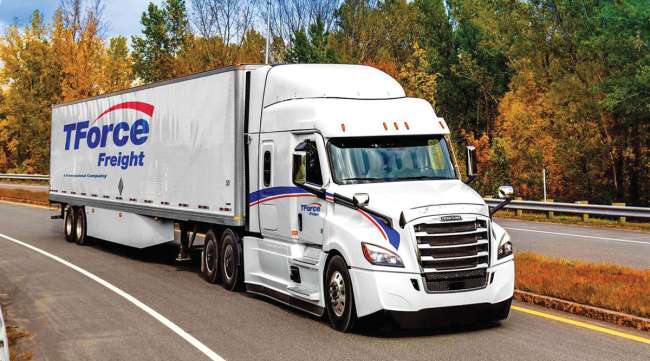Staff Reporter
TFI Buys Manitoba-Based TL, LTL Carrier Keystone Western

[Stay on top of transportation news: Get TTNews in your inbox.]
TFI International bought truckload and less-than-truckload carrier Keystone Western for an undisclosed sum, the company said in a LinkedIn post.
Keystone Western is the latest tuck-in acquisition from Montreal-based TFI, one of nine so far in 2024. The company inked 12 in 2023, including the $1 billion acquisition of top-ranked flatbed carrier Daseke.
Keystone Western specializes in dry van, flatbed and heavy haul carriage. The company has fewer than 100 tractors, according to Federal Motor Carrier Safety Administration records.
Grande Pointe, Manitoba-based Keystone Western operates terminals in Winnipeg, Manitoba; Waterloo, Ontario; and Vancouver, British Columbia.
TFI said the latest deal would strengthen its “North American network” and enhances service. TFI ranks No. 4 on the Transport Topics Top 100 list of the largest for-hire carriers in North America and No. 39 on the TT Top 100 list of the largest logistics companies.
Further deals for acquisition-hungry TFI are in the cards, CEO Alain Bédard confirmed during the company’s third-quarter 2024 earnings call Oct. 22.
“Every year we always invest $200 million to $300 million on tuck-ins, M&A, et cetera, et cetera. And you’ll see us doing the same thing in 2025, OK?” he said. “In terms of M&A, I mean, we’ve always been very patient. We have a saying within TFI: You make your money on the buying, never on the selling.
RELATED: TFI Eyes Large Truckload, LTL Acquisitions in 2025, 2026
“Our pipeline is solid. We have lots of opportunities. It’s just that we have to be patient. If you go back to ’23, we walked away [from] one deal because we couldn’t agree on the valuation. And that’s it. ... We’re very, very patient,” he said, adding: “Because the freight environment has been so weak, the environment for M&A is good for us, right?”

Bédard
However, bigger deals are in the works for TFI than domestic tuck-ins, such as Keystone Western, CMW Express or Groupe CRS Express, as the carrier prepares to spin off its truckload division.
During the company’s second-quarter earnings call, Bédard said a major acquisition was in the cards for 2025, likely in the LTL sector, a prospect he doubled down on during the most recent call with analysts. TFI ranks No. 8 on TT’s lists of the top LTL and truckload carriers.
“LTL, we have to do more. I mean we’re a small player in LTL in the U.S. We’re the dominant player in Canada. So we will probably never be the dominant player in the U.S., but we have to be more of like maybe a No. 3 or No. 4, not No. 6 or No. 7,” he said, adding that an average of 22,000 shipments a day meant TFI was too small in the sector.
The company’s U.S. LTL operations posted revenue before fuel surcharge of $531 million in Q3, down 8.6% from $581 million in the year-ago period as a result of a 2% drop in tonnage and a 35% decline on ground freight pricing revenue.
Host Seth Clevenger and Features Coordinator Mike Senatore take you behind the scenes to unveil the 2024 Top 50 Global Freight Companies. Tune in above or by going to RoadSigns.ttnews.com.
The unit’s operating ratio in Q3 was 92.2, compared with 90.8 a year earlier. Operating ratio provides insight into how well a company is balancing its costs and revenue generation. The lower the ratio, the better a company’s performance.
TFI’s Canadian LTL operations posted an operating ratio of 76.3, compared with 77.2 in the year-ago period.
Bédard, as has regularly been the case in recent quarters, bemoaned the performance of TFI’s U.S. LTL operations, TForce Freight — the backbone of which it bought from UPS in 2021 — during the Q3 call.
“So our focus is really to improve our cost basis,” he said. “Our focus is really to improve our cost base and also improve our service. If you look at the last report from [Mastio], I mean our service, according to this survey, is the worst of the top seven carriers in the U.S. So it’s really a focus of ours.”
Want more news? Listen to today's daily briefing above or go here for more info
A quarter earlier, Bédard — who is unapologetically frank during the calls — demanded the unit go on a diet. “We’re too fat. We’ve got too many costs. The way we’re going to win is to be lean and mean,” Bédard told analysts July 25. “Let’s go on a diet. That’s the only way we’re going to cut costs.”
Three months later, Bédard showed particular irritation at deterioration in the unit’s claims ratio in Q3.
“If you look at our claim ratio, we were going in the right direction, but then whoops [along comes] Q3, we dropped the ball, right? So, our claims ratio is at 0.8% of revenue. Our Canadian LTL, our claim ratio is 0.2%, which is like best in class. We used to be at 0.4%, 0.5%. Well, now we’re at 0.8%. So, guys, let’s not drop the ball. Let’s focus on service. Let’s not miss any pickup. Let’s be on time with our deliveries,” he told analysts and employees on the call.





